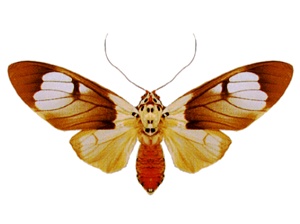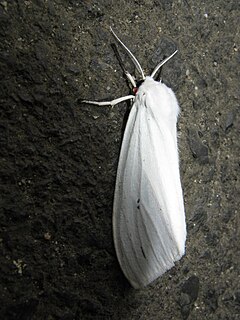
The Arctiinae are a large and diverse subfamily of moths, with around 11,000 species found all over the world, including 6,000 neotropical species. This group includes the groups commonly known as tiger moths, which usually have bright colours, footmen, which are usually much drabber, lichen moths, and wasp moths. Many species have "hairy" caterpillars that are popularly known as woolly bears or woolly worms. The scientific name of this subfamily refers to this hairiness. Some species within the Arctiinae have the word tussock in their common name due to people misidentifying them as members of the Lymantriinae based on the characteristics of the larvae.

The Arctiini are a tribe of tiger moths in the family Erebidae.
Aethalida is a genus of tiger moths in the family Erebidae that occur in the Sundaland and Philippines.

Amerila is a genus of moths in the subfamily Arctiinae. A number of species in this genus have a special defence mechanism when they are in their adult stage. When disturbed, they exude a frothy yellow fluid from glands beside the eyes, while making a sizzling noise to ward off their attacker. Similar behaviour has been observed in fertilised females of the North-American moth Utetheisa ornatrix.

Argina is a genus of tiger moths in the family Erebidae. They are distributed throughout Africa, Mauritius, China, India, Sri Lanka, Myanmar, Andaman Islands, New Guinea and Australia.

Chionarctia is a genus of tiger moths in the family Erebidae erected by Nobutoyo Kôda in 1859. The moths in the genus are found in east Asia.

Creatonotos is a genus of tiger moths in the family Erebidae. The moths in the genus are found in the Afrotropics, South and East Asia, Sundaland and Australia.
Dolgoma is a genus of moths in the family Erebidae. The genus was erected by Frederic Moore in 1878.
Eyralpenus is a genus of tiger moths in the family Erebidae. The genus was erected by Arthur Gardiner Butler in 1875. The moths in the genus are found in the Afrotropics.

Palearctia is a genus of tiger moths in the family Erebidae.
Leucaloa is a genus of tiger moths in the family Erebidae. The moths in the genus are found in the Afrotropics.

Lyclene is a genus of lichen moths of the family Erebidae, subfamily Arctiinae. The genus was erected by Frederic Moore in 1860.
Oroncus is a genus of tiger moths in the family Erebidae.
Satara is a genus of moths in the family Erebidae from Sulawesi and South India. The genus was erected by Francis Walker in 1865.
Juxtarctia is a genus of tiger moths in the family Erebidae. The genus is monotypic, containing only one species, Juxtarctia multiguttata described by Francis Walker in 1855, which is endemic for the Himalayas.
Madagascarctia is a genus of moths in the subfamily Arctiinae from Madagascar. The genus was erected by Vladimir Viktorovitch Dubatolov in 2006. As per David T. Goodger and Allan Watson (1995) the species of this genus have whitish wings speckled with brown.
Ustjuzhania is a genus of moths in the subfamily Arctiinae from southern and eastern Africa. The genus was erected by Vladimir Viktorovitch Dubatolov in 2009.
Toulgarctia is a genus of moths in the subfamily Arctiinae from Madagascar. The genus was erected by Vladimir Viktorovitch Dubatolov and Patrick G. Haynes in 2008.

Amerila astreus is a moth of subfamily Arctiinae described by Dru Drury in 1773. It is found from the Oriental region to New Guinea. The species is found in primary and secondary habitats ranging from lowlands to montane regions.

Mangina is a genus of tiger moths in the family Erebidae.










